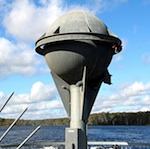In the springtime, many man-made reservoirs are drawn down several feet by the U.S. Army Corps of Engineers. Waters recede from banks all around these often massive bodies of water, exposing areas otherwise covered in deep, murky water. Reasons for this vary from power generation and irrigation to anticipation of heavy spring rains. Regardless of the reason, these draw downs give you an excellent opportunity to improve the fishing at your favorite spots for years to come. Read on as we detail the advantages that temporary water drops provide.
Mapping out the Terrain
Unless you have sonar (and can read it exceedingly well), the terrain on the bottom of most lakes is something of a mystery. Sure, there are a few spots where you know the fishing is almost always good. But do you know the exact reasons why?
 During a reservoir draw down, you can find this information out pretty easily. Take out a watercraft or walk the shoreline and seek out the spots you fish out of most heavily. With any luck, you’ll be able to see the point, bottom irregularity, or natural structure that fish congregate around.
During a reservoir draw down, you can find this information out pretty easily. Take out a watercraft or walk the shoreline and seek out the spots you fish out of most heavily. With any luck, you’ll be able to see the point, bottom irregularity, or natural structure that fish congregate around.
What’s more, this same technique can be used for finding new honey holes in places you wouldn’t normally expect. Keep an eye out for rock piles, branch aggregates, and other irregularities that fish might be attracted to when the water’s high. Many serious fishermen will even bring a lake map with them as they scan the shoreline, placing structure markers that will prove very useful in the future.
Making Terrain of your Own
If the reservoir draw down reveals that your favorite fishing area is relatively bare, the extra several feet of shoreline gives you the perfect chance to fix that little problem. While it is possible to build and sink structure for fish when the water’s high, making a structure pile right where you want it is unmatched in terms of convenience and effectiveness.
For common game fish like Largemouth Bass and Crappie, the most popular form of man-made structure comes straight from nature. Start by gathering several large rocks, which will serve as the base of your structure. Then, pile large logs on top of them – the goal being to make a large, relatively condensed aggregate. Under ideal circumstances, you’ll be able build the pile at a depth where fish normally hold when the water is at a normal level. But there’s no problem with going a little shallower if the shoreline exposed during the draw down doesn’t quite reach that depth.
Generally speaking, draw downs in man-made reservoirs are a bit of a bummer. They limit fishing from the shoreline and make boating tougher – especially in coves. But they can also prove very useful to the avid fisherman. If you’re willing to put in the work to set up future fishing during a draw down, it’s safe to say that you’ll be reaping those rewards for some time to come.

